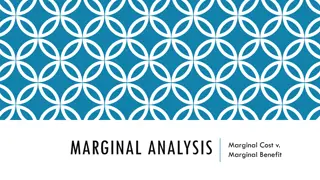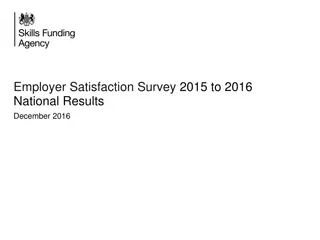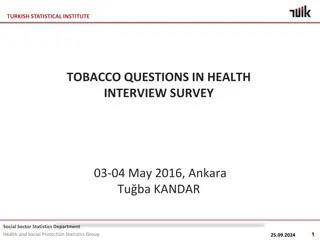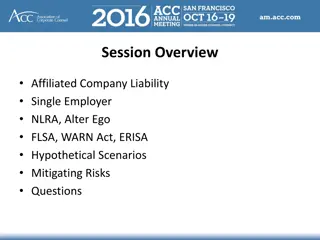
Insights into Health Benefit Trends: Premium Contributions and Increases 1999-2015
Explore the evolution of health insurance premiums, worker contributions, and employer contributions from 1999 to 2015 through an in-depth analysis of the Kaiser/HRET Survey of Employer-Sponsored Health Benefits. Discover key trends in premium amounts, annual increases, cumulative impacts, and variations based on firm sizes, shedding light on the changing landscape of healthcare coverage.
Download Presentation

Please find below an Image/Link to download the presentation.
The content on the website is provided AS IS for your information and personal use only. It may not be sold, licensed, or shared on other websites without obtaining consent from the author. If you encounter any issues during the download, it is possible that the publisher has removed the file from their server.
You are allowed to download the files provided on this website for personal or commercial use, subject to the condition that they are used lawfully. All files are the property of their respective owners.
The content on the website is provided AS IS for your information and personal use only. It may not be sold, licensed, or shared on other websites without obtaining consent from the author.
E N D
Presentation Transcript
Employer Health Benefit Survey 2015 Release Slides September 22, 2015
Average Annual Worker and Employer Contributions to Premiums and Total Premiums for Family Coverage, 1999-2015 $5,791 1999 $1,543 $4,247 Worker Contribution $6,438* 2000 $1,619 $4,819* $7,061* Employer Contribution 2001 $1,787* $5,274* $8,003* 2002 $2,137* $5,866* $9,068* 2003 $2,412* $6,657* $9,950* 2004 $2,661* $7,289* $10,880* 2005 $2,713 $8,167* $11,480* 2006 $2,973* $8,508* $12,106* 2007 $3,281* $8,824 $12,680* 2008 $3,354 $9,325* $13,375* 2009 $3,515 $9,860* $13,770* 2010 $3,997* $9,773 $15,073* 2011 $4,129 $10,944* $15,745* 2012 $4,316 $11,429* $16,351* 2013 $4,565 $11,786 $16,834* 2014 $4,823 $12,011 2015 $4,955 $12,591* $17,545* * Estimate is statistically different from estimate for the previous year shown (p<.05). SOURCE: Kaiser/HRET Survey of Employer-Sponsored Health Benefits, 1999-2015.
Average Annual Premium Increases for Family Coverage, 1999-2015 50% 45% 40% 35% 30% 25% 20% 15% 11% 10% 5% 5% 5% 0% 1999 to 2005 2005 to 2010 2010 to 2015 SOURCE: Kaiser/HRET Survey of Employer-Sponsored Health Benefits, 1999-2015
Cumulative Increases in Health Insurance Premiums, Workers Contributions to Premiums, Inflation, and Workers Earnings, 1999-2015 250% Health Insurance Premiums Workers' Contribution to Premiums Workers' Earnings Overall Inflation 221% 200% 203% 158% 150% 138% 100% 88% 75% 56% 42% 50% 20% 42% 31% 17% 0% 1999 2000 2001 2002 2003 2004 2005 2006 2007 2008 2009 2010 2011 2012 2013 2014 2015 SOURCE: Kaiser/HRET Survey of Employer-Sponsored Health Benefits, 1999-2015. Bureau of Labor Statistics, Consumer Price Index, U.S. City Average of Annual Inflation (April to April), 1999-2015; Bureau of Labor Statistics, Seasonally Adjusted Data from the Current Employment Statistics Survey, 1999-2015 (April to April).
Average Annual Worker and Employer Contributions to Premiums and Total Premiums for Single and Family Coverage, by Firm Size, 2015 Single Coverage Family Coverage $17,983* $17,545 $16,625* Employer Contribution Worker Contribution $10,720* $12,591 $13,390* $6,251 $6,289 $6,163 $5,142 $5,179 $5,264 $5,904* $4,955 $4,549* $1,146* $1,071 $899* Small Firms (3 to 199 Workers) Large Firms (200 or More Workers) All Firms Small Firms (3 to 199 Workers) Large Firms (200 or More Workers) All Firms * Estimate is statistically different between All Large Firms and All Small Firms estimate (p<.05). SOURCE: Kaiser/HRET Survey of Employer-Sponsored Health Benefits, 2015.
Average Annual Worker and Employer Contributions to Premiums and Total Premiums for Single and Family Coverage, by Firm Wage Level, 2015 Single Coverage Family Coverage $17,665* $17,545 $16,182* Employer Contribution Worker Contribution $9,801* $12,591 $12,835* $6,251 $6,307* $5,606* $5,238* $5,179 $4,507* $6,382* $4,955 $4,829* $1,099 $1,069 $1,071 Less Than 35% are Lower-Wage Level 35% or More are Lower-Wage Level All Firms Less Than 35% are Lower-Wage Level 35% or More are Lower-Wage Level All Firms * Estimate is statistically different between All Large Firms and All Small Firms estimate (p<.05). NOTE: Lower-wage level is $23,000 annually or less, the 25th percentile for workers earnings nationally. SOURCE: Kaiser/HRET Survey of Employer-Sponsored Health Benefits, 2015.
Percentage of Covered Workers With a General Annual Deductible for Single Coverage, 2006-2015 90% 81% 80% 78%* 80% 74% 72% 70%* 70% 63% 59%* 59% 60% 55% 50% 40% 30% 20% 10% 0% 2006 2007 2008 2009 2010 2011 2012 2013 2014 2015 * Estimate is statistically different from estimate for the previous year shown (p<.05). SOURCE: Kaiser/HRET Survey of Employer-Sponsored Health Benefits, 2006-2015.
Average General Annual Deductible for Covered Workers Enrolled in Single Coverage, 2006-2015 $1,318 $1,275 $1,217 $1,135 $1,175 $1,097* $1,075 $991 $1,077 $989* $975 $917* $883 $875 $826* $802 $735* $775 $747* $675 $616 $646* $584 Average Deductible Among Covered Workers With a Deductible $575 $533* Average Deductible Among All Covered Workers $475 $433* $375 $343 $303 $275 2006 2007 2008 2009 2010 2011 2012 2013 2014 2015 * Estimate is statistically different from estimate for the previous year shown (p<.05). NOTES: Average general annual deductible is among all covered workers. Workers in plans without a general annual deductible for in-network services are assigned a value of zero. SOURCE: Kaiser/HRET Survey of Employer-Sponsored Health Benefits, 2006-2015.
Cumulative Increases in Health Insurance Premiums, General Annual Deductibles, Inflation, and Workers Earnings, 2010-2015 80% Overall Inflation Workers Earnings 70% 67% Single Coverage Deductibles, all Workers 60% Single Coverage Premiums 50% 40% 30% 24% 20% 10% 10% 9% 0% 2010 2011 2012 2013 2014 2015 NOTE: Average general annual deductible is among all covered workers. Workers in plans without a general annual deductible for in-network services are assigned a value of zero. SOURCE: Kaiser/HRET Survey of Employer-Sponsored Health Benefits, 2010-2015. Bureau of Labor Statistics, Consumer Price Index, U.S. City Average of Annual Inflation (April to April), 2010-2015; Bureau of Labor Statistics, Seasonally Adjusted Data from the Current Employment Statistics Survey, 2010-2015 (April to April).
Percentage of Covered Workers Enrolled in a Plan with a General Annual Deductible of $1,000 or More for Single Coverage, By Firm Size, 2006-2015 All Small Firms (3-199 Workers) 70% 63% All Large Firms (200 or More Workers) 61% 58%* All Firms 60% 50% 49% 46% 46% 50% 41% 40% 38% 40% 35%* 34% 31% 39%* 27%* 30% 32% 22%* 21%* 28% 18%* 26% 16% 20% 22%* 12%* 10% 17% 10% 13%* 9% 8% 6% 0% 2006 2007 2008 2009 2010 2011 2012 2013 2014 2015 * Estimate is statistically different from estimate for the previous year shown (p<.05). NOTE: These estimates include workers enrolled in HDHP/SOs and other plan types. Average general annual health plan deductibles for PPOs, POS plans, and HDHP/SOs are for in-network services. SOURCE: Kaiser/HRET Survey of Employer-Sponsored Health Benefits, 2006-2015.
Distribution of Health Plan Enrollment for Covered Workers, by Plan Type, 1988-2015 Conventional HMO PPO POS HDHP/SO 1988 73% 16% 26% 11% 1993 46% 21% 7% 1996 27% 31% 28% 14% 1999 10% 28% 39% 24% 2000 8% 29% 42% 21% 2001 7% 24% 46% 23% 2002 4% 27% 52% 18% 2003 5% 24% 54% 17% 2004 5% 25% 55% 15% 2005 3% 21% 61% 15% 2006 3% 20% 60% 13% 4% 2007 3% 21% 57% 13% 5% 2008 2% 20% 58% 12% 8% 2009 1% 20% 60% 10% 8% 2010 1% 19% 58% 8% 13% 2011 17% 55% 10% 17% 1% 2012 16% 56% 9% 19% 1% 2013 14% 57% 9% 20% 1% 2014 <1% 13% 58% 8% 20% 2015 1% 14% 52% 10% 24% NOTE: Information was not obtained for POS plans in 1988. A portion of the change in plan type enrollment for 2005 is likely attributable to incorporating more recent Census Bureau estimates of the number of state and local government workers and removing federal workers from the weights. See the Survey Design and Methods section from the 2005 Kaiser/HRET Survey of Employer-Sponsored Health Benefits for additional information. SOURCE: Kaiser/HRET Survey of Employer-Sponsored Health Benefits, 1999-2015; KPMG Survey of Employer-Sponsored Health Benefits, 1993, 1996; The Health Insurance Association of America (HIAA), 1988.
Percentage of Firms Offering Health Benefits, by Firm Size, 1999-2015 98% 98% 98% 98% 99% 98% 99% 99%* 100% 97% 97% 97% 97% 96% 96%* 96% 95% 94% 96% 96% 94%* 94% 93% 93% 93% 90% 92% 92% 91% 91% 91% 91% 90% 89% 88% 87% 80% 3 to 49 Workers 50 to 99 Workers 100 or more 69%* 68% 68% 70% ALL FIRMS 66% 66% 66% 63% 63% 66% 66% 61% 60%*61% 66%* 60% 64% 59% 59% 63% 63% 60% 57% 57% 61% 60% 55% 59% 58% 57% 57% 57%* 56% 55% 54% 50% 52% 40% 1999 2000 2001 2002 2003 2004 2005 2006 2007 2008 2009 2010 2011 2012 2013 2014 2015 *Estimate is statistically different from estimate for the previous year shown (p<.05). NOTE: Estimates presented in this exhibit are based on the sample of both firms that completed the entire survey and those that answered just one question. For more information, see the Survey Methods Section. SOURCE: Kaiser/HRET Survey of Employer-Sponsored Health Benefits, 1999-2015.
Eligibility, Take-Up Rate, and Coverage for Workers in Firms Offering Health Benefits, 1999-2015 100% Percentage Eligible Percentage of Eligible That Take Up Percentage Covered 90% 85% 85% 84% 84% 84% 83% 83% 83% 82% 82% 81% 81% 81% 80% 80% 80% 83% 79% 80% 81% 81%* 81% 80% 80% 80% 79% 79% 79% 79% 79% 79% 78% 77% 77% 77% 70% 70% 68% 68% 68% 67% 66% 66% 65% 65% 65% 65% 65% 63% 63% 62% 62% 62% 60% 50% 1999 2000 2001 2002 2003 2004 2005 2006 2007 2008 2009 2010 2011 2012 2013 2014 2015 * Estimate is statistically different from estimate for the previous year shown (p<.05). SOURCE: Kaiser/HRET Survey of Employer-Sponsored Health Benefits, 1999-2014.
Among Firms with More Than 50 Employees and Who Offer Health Benefits, The Percentage of Firms Considering Offering Benefits Through a Private Exchange, 2015 100% 7% 7% 80% Yes No 68% 60% 76% Don't Know 40% 20% 26% 3% 2% 17% 0% Considering Offering Benefits Through a Private Exchange Considering a Defined Contribution Percentage of Covered Workers Enrolled at a Firm That Offers Benefits Through a Private or Corporate Exchange Percentage of Firms offering Health Benefits Which Offer Coverage Through a Private or Corporate Exchange These questions were not asked of firms that already offer health benefits through a private exchange. NOTE: A private exchange is one created by a consulting company, not by a state or federal government. Private exchanges allow employees to choose from several health benefit options offered on the exchange. A defined premium contribution is a set dollar amount offered to the employee. Employees may then select one of several plans and the employee pays the difference between the defined contribution and the cost of the health insurance option they choose. SOURCE: Kaiser/HRET Survey of Employer-Sponsored Health Benefits, 2015.
Among Large Firms (200 or More Workers) Offering Health Benefits, Percentage of Firms Offering Incentives for Various Wellness and Health Promotion Activities, 2015 Health Risk Assessments Biometric Screening Wellness Programs 100% 90% 81% 80% 70% 60% 50% 50% 50% 40% 31% 31% 28% 30% 20% 10% 0% Offers or Requires Health Risk Assessment Also has an Incentive to Complete Health Risk Assessment Offers or Asks Employees to Complete Biometeric Screening Also has an Incentive To Complete Biometric Screening Offers Specific Wellness Program Also has an Incentive or Penalty to Participate in Wellness Programs Firms which offer either Programs to Help Employees Stop Smoking , Programs to Help Employees Lose Weight , or Other Lifestyle or Behavioral Coaching . SOURCE: Kaiser/HRET Survey of Employer-Sponsored Health Benefits, 2015.
Among Firms Offering Health Benefits, Percentage of Firms Offering Specific Wellness Program to Their Employees, by Firm Size, 2015 100% All Small Firms (3-199 Workers) All Large Firms (200 or More Workers) 90% 81%* 80% 71%* 68%* 70% 61%* 60% 49%* 50% 41%* 39%* 39%* 40% 30% 20% 10% 0% Programs to Help Employees Stop Smoking Programs to Help Employees Lose Weight Other Lifestyle or Behavioral Coaching At Least One of These Programs * Estimate is statistically different between All Small Firms and All Large Firms (p<.05). NOTE: Other Lifestyle or Behavioral Coaching can include health education classes, stress management, or substance abuse counseling. SOURCE: Kaiser/HRET Survey of Employer-Sponsored Health Benefits, 2015.
Among Large Firms Offering Incentives for Workers Who Participate In or Complete Wellness Programs, Maximum Annual Value of the Reward for Wellness and Health Promotion Programs, Including Incentives for Health Risk Assessment and Biometric Screening, 2015 100% Maximum Annual Value of the Reward for Wellness and Health Promotion Programs Altogether (All Large Firms-200 or More Workers) 80% 60% 41% 40% 22% 21% 20% 11% 5% 0% $150 or Less >$150 to $500 >$500 to $1,000 >$1,000 to $2,000 Greater than $2,000 NOTE: Firms with at least one of the listed wellness programs were asked to report the maximum reward or penalty an employee could earn for all of the firm's health promotion activities combined. For some employers, the maximum incentive may include rewards or penalties for activities related to health risk assessments and biometric screening. Listed programs include: Programs to Help Employees Stop Smoking , Programs to Help Employees Lose Weight , or Other Lifestyle or Behavioral Coaching . SOURCE: Kaiser/HRET Survey of Employer-Sponsored Health Benefits, 2015.
Among Firms Offering Health Benefits, Percentage of Firms Who Have Incorporated Various Features into Their Provider Networks, by Firm Size, 2015 30% All Small Firms (3-199 Workers) All Large Firms (200 or More Workers) 24% 20% 17% 9% 10% 8% 6% 5% 0% Largest Plan Includes a High-Performance or Tiered Provider Network Firm/Insurer Eliminated Hospitals or Health Systems from Network to Reduce Cost Firm Offers a Plan Considered a Narrow Network Plan Note: A high performance network is one that groups providers within the network based on quality, cost, and/or efficiency of care they deliver. SOURCE: Kaiser/HRET Survey of Employer-Sponsored Health Benefits, 2015.
Among Firms Whose Plan with the Largest Enrollment Covers Specialty Drugs, Percentage of Firms Which Use the Following Strategies to Contain Specialty Drug Cost, by Firm Size, 2015 100% All Small Firms (3-199 Workers) All Large Firms (200 or More Workers) 90% 80% 70% 60% 50% 40% 31% 30% 30% 25% 20% 20% 14%* 14% 10% 8% 7% 7% 7% 10% 6% 4% 2% 0% Separate Cost Sharing Tier Specialty Drug Carve Out Specialty Pharmacy Dispensing Program Step Therapies Tight Limits on the Number of Units Administered at a Single Time Utilization Management Programs Other SOURCE: Kaiser/HRET Survey of Employer-Sponsored Health Benefits, 2015.
Among Firms Offering Health Benefits with 50 or More Full-Time- Equivalents , Percentage of Firms That Took Various Actions, by Firm Size, 2015 All Large Firms (200 or more Workers) 3% Increased the waiting period before new employees are eligible for health benefits All Firms (50 or More FTEs) 2% Reduced the number of full time employees the firm intended to hire because of the cost of providing health benefits 5% 4% Changed some job classifications from part time to full time so that employees would be eligible 13% 10% Changed some job classifications from full time to part time so employees would NOT be eligible 3% 4% 0% 10% 20% 30% 40% 50% 60% 70% 80% 90% 100% Firms were asked if they took the relevant action in response to the Employer-Shared Responsibility Provisions. Firms with 50 or more full-time equivalents were asked these questions. A significant number of employers, mostly large employers did not know how many FTEs they employed. In these cases, firms with 50 or more workers were asked these questions. Source: Kaiser/HRET Survey of Employer-Sponsored Health Benefits, 2015.
Among Firms Offering Health Benefits with 100 or More Full-Time- Equivalents , Percentage of Firms That Took Various Actions, 2015 Extended Eligibility to Groups of Workers not Previously Eligible because of the Employer Shared Responsibility Provisions 21% Offered More Comprehensive Benefits to Some Workers who Previously were only offered a Limited Benefit Plan 5% Offers a Health Plan that Meets Minimum Standards for Value and Affordability 96% 0% 10% 20% 30% 40% 50% 60% 70% 80% 90% 100% Response are among firms with 100 or more full-time equivalents. A significant number of employers, mostly large employers did not know how many FTEs they employed. In these cases, the responses for firms with 100 or more workers are included. Two percent of firms did not offer a health plan that meets minimum standards for value and affordability and three percent of firms did not know. Source: Kaiser/HRET Survey of Employer-Sponsored Health Benefits, 2015.
Among Firms Offering Health Benefits, Percentage of Firms That Have Taken Various Actions in Anticipation of the Excise Tax on High- Cost Plans, by Firm Size, 2015 All Small Firms (3 to 199 More Workers) 100% All Large Firms (200 or More Workers) 90% 80% 71% 70% 60% 53% 50% 38% 40% 30% 17% 20% 13% 8% 8% 7% 6% 10% 2% 0% Conducted an analysis to determine if plans will exceed limits Made changes to plan s coverage or cost sharing to avoid exceeding limits Switched to a lower cost plan Other None of these SOURCE: Kaiser/HRET Survey of Employer-Sponsored Health Benefits, 2015.
Among Large Firms (200 or More Workers) Offering Health Benefits Who Indicated That Have They Changed Their Plan or Switched Carriers In Anticipation of the Excise Tax on High-Cost Health Plans, Percentage of Firms Which Have Taken Various Actions, 2015 100% Actions Taken by Large Firms in Anticipation of the High Cost Plan Tax 90% 80% 70% 64% 60% 50% 40% 34% 30% 24% 18% 16% 20% 10% 10% 0% Increased cost sharing Reduced the scope of covered services Moved benefit options to account- based plans such as an HRA or HSA Increase incentives to use less costly providers Considered offering health insurance through a private exchange Other Among firms who offer either an HSA-qualified plan or a high deductible plan paired with a health reimbursement arrangement. Note: Sixteen percent of large firms offering health benefits report that they have changed their benefit plans or moved to lower cost plans in anticipation of the assessment SOURCE: Kaiser/HRET Survey of Employer-Sponsored Health Benefits, 2015.
U.S. health care spending per capita has risen at historically low rates recently, but is expected to pick up Average annual growth rate of health spending per capita for 1970 s 1990 s; Annual change in actual health spending per capita 2000 2013 and projected health spending per capita (2014 2024) Actual Projected 14% 12.0% 12% 9.9% 10% 8.6% 7.6% 8% 7.4% 6.2%5.8%5.5%5.3% 6.1% 6% 5.5% 5.2%5.3% 5.3% 5.3%5.2%5.1% 4.7%4.4% 4.5%4.6% 4.0% 3.8% 4% 2.9%3.1%3.2%3.4% 2.9% 2% 0% 1970s 1980s 1990s 2014 2021 2000 2001 2002 2003 2004 2005 2006 2007 2008 2009 2010 2011 2012 2013 2015 2016 2017 2018 2019 2020 2022 2023 2024 SOURCE: Kaiser Family Foundation analysis of National Health Expenditure (NHE) data from Centers for Medicare and Medicaid Services, Office of the Actuary, National Health Statistics Group.






















